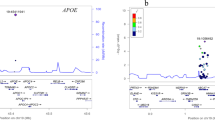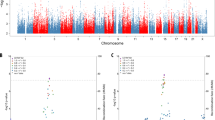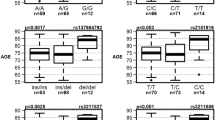Abstract
Alzheimer's disease (AD) is a disorder characterized by a progressive deterioration in memory and other cognitive functions. Four genes associated with early onset AD have been identified1, 2, 3, 4, 5 but familial AD is rare.6 The majority of late onset AD (LOAD) is caused by a complex inheritance with several genes interacting with environmental factors. The ε4 allele of the apolipoprotein E (APOE) gene has been reported worldwide as a risk factor associated with LOAD.7, 8, 9, 10 The short variant of a polymorphism in the transcriptional region of the serotonin transporter gene (5-HTTLPR) was analyzed in several psychiatric conditions11, 12, 13, 14, 15 and found to be more frequently associated with European16 and Brazilian LOAD patients.17, 18 Recently, allelic associations with LOAD were reported for five other loci,19, 20 the most significant for one X-linked 202-bp allele, at the DXS1047 locus. We have analyzed this locus in Brazilian LOAD patients and observed that the 202-bp allele was not significantly more frequent among patients. In contrast, two other alleles (200 bp and 208 bp) were less frequent among AD male patients than in controls, confirming the importance of replicating association studies in different populations.
This is a preview of subscription content, access via your institution
Access options
Subscribe to this journal
Receive 12 print issues and online access
$259.00 per year
only $21.58 per issue
Buy this article
- Purchase on Springer Link
- Instant access to full article PDF
Prices may be subject to local taxes which are calculated during checkout
Similar content being viewed by others
References
Cruts M, Backhovens H, Wang SY, Van Gassen G, Therens J, De Jonghe C et al. Molecular genetic analysis of familial early-onset Alzheimer's disease linked to chromosome 14q.24.3 Hum Molec Genet 1995; 4: 2363–2371
Cruts M, Hendriks L, Broeckhoen CV . The presenilin genes: a new gene family involved in Alzheimer disease pathology Hum Molec Genet 1996; 5: 1449–1455
Sisodia SS, Kim SH, Thinakaran G . Function and dysfunction of the presenilins Am J Hum Genet 1999; 65: 7–12
Haass C, De Strooper B . The presenilins in Alzheimer's disease—proteolysis holds the key (Review) Science 1999; 286: 916–919
Pericak-Vance MA, Bass M, Yamaoka LH, Gaskell PC, Scott WK, Terwedow HA et al. Complete genomic screen in late-onset familial Alzheimer disease—evidence for a new locus on chromosome 12 JAMA 1997; 278: 1237–1241
Kehoe P, Wavrant-de Vrieze F, Crook R, Wu WS, Holmans P, Fenton I et al. A full genome scan for late onset Alzheimer's disease Hum Molec Genet 1999; 8: 237–245
Saunders AM, Schmader K, Breitner JCS, Benson MD, Brown WT, Goldfarb L et al. Apolipoprotein E ε4 allele distribution in late-onset Alzheimer's disease and in other amyloid-forming disease Lancet 1993; 432: 710–711
St Clair D, Rennie M, Slorack E, Norrman J, Yates C, Carothers A . Apolipoprotein E ε4 allele is a risk factor for familial and sporadic presenile A Alzheimer's disease in both homozygote and heterozygote carriers J Med Genet 1995; 32: 642–644
Meyer MR, Tschanz JT, Norton MC, Welsh-Bohmer KA, Steffens DC, Wyse BW et al. APOE genotype predicts when—not whether—one is predisposed to develop Alzheimer disease Nature Genet 1998; 19: 321–322
Oliveira JRM, Lima-Filho JL, Shimokomaki CM, Okuma M, Passos-Bueno MR, Zatz M et al. The use of apolipoprotein E genotype for preclinical detection of risk groups for Alzheimer's disease Am J Med Genet) 1997; 74: 216–217
Collier DA, Stöber G, Li T, Heils A, Catalano M, Di Bella D et al. A novel functional polymorphism within the promoter of the serotonin transporter gene: possible role in susceptibility to affective disorders—role of 5-HTT in affective disorders Mol Psychiatry 1996; 1: 453–460
Lesch KP, Bengel D, Heils A, Sabol SZ, Greenberg BD, Petri S et al. Association of anxiety-related traits with a polymorphism in the serotonin transporter gene regulatory region Science 1996; 274: 1527–1531
Heils A, Teyfek A, Petri S, Stöber G, Ruederer P, Bengel D et al. Allelic variation of human serotonin transporter gene expression J Neurochem 1996; 66: 2621–2624
Oliveira JRM, Otto PA, Vallada H, Lauriano V, Elkis H, Lafer B et al. Analysis of a novel functional polymorphism within the promoter region of the serotonin transporter gene (5-HTT) in Brazilian patients affected by bipolar disorder and schizophrenia Am J Med Genet 1998; 81: 1–3
Kunugi H, Hattori M, Kato T, Tatsumi M, Sakai T, Sasaki T . Serotonin transporter gene polymorphisms: ethnic difference and possible association with bipolar affective disorder Mol Psychiatry 1997; 2: 457–462
Li T, Holmes C, Sham PC, Vallada HP, Berkett J, Kirov G et al. Allelic functional variation of serotonin transporter expression is a susceptibility factor for late onset Alzheimer's disease NeuroReport 1997; 8: 683–686
Oliveira JRM, Gallindo RM, Maia LGS, Brito-Marques PR, Otto PA, Passos-Bueno MR et al. The short variant of the polymorphism within the promoter region of the serotonin transporter gene is a risk factor for late onset Alzheimer disease Mol Psychiatry 1998; 3: 438-441
Oliveira JRM, Shimokomaki CM, Brito-Marques PR, Gallindo RM, Okuma M, Mara LGS et al. The association of the short variant of the 5-HTTLPR polymorphism and the apoE ε4 allele does not increase the risk for late onset Alzheimer's disease Mol Psychiatry 1999; 4: 19–20
Zubenko GS, Hughes HB, Stiffer JE, Hurtt MR, Kaplan BB . A genome survey for novel Alzheimer's disease risk loci: results at 10-cM resolution Genomics 1998; 50: 121–128
Zubenko GS, Stiffer JE, Hughes HB, Hurtt MR, Kaplan BB . Initial result of a genome survey for novel Alzheimer's disease risk genes: association with a locus on the X chromosome Am J Med Genet 1998; 81: 98–107 and 196–205
Zubenko GS, Hughes HB, Stiffler JS . Clinical and neurological correlates of DXS1047 genotype in Alzheimer's disease Biol Psychiatry 1999; 46: 173–171
Payami H, Zareparsi D, Montee KR, Sexton GJ, Kaye JA, Bird TD et al. Gender difference in apolipoprotein E – associated risk for familial Alzheimer disease: a possible clue to the higher incidence of Alzheimer disease in women Am J Hum Genet 1996; 58: 803–811
Gambassi G, Lapane KL, Landi F, Sgadari A, Mor V, Bernabei R . Gender differences in the relation between comorbidity and mortality of patients with Alzheimer's disease Neurology 1999; 53: 508–516
Deckert J, Catalano M, Syagailo YV, Bosi M, Okladnova O, Di Bella D et al. Excess of high activity monoamine oxidase A gene promoter alleles in female patients with panic disorder Hum Molec Genet 1999; 8: 621–624
Kehoe P, Krawczak M, Harper P, Owen MJ, Jones LA . Age of onset in Huntington disease: sex specific influence of apoliprotein E genotype and normal CAG repeat length J Med Genet 1999; 36: 108–111
Van Someren EJW, Hagebeuk EEO, Lijzenga C, Scheltens P, de Rooji SEA, Jonker G et al. Circadian rest-activity rhythm disturbances in Alzheimer's disease (Abstract) Biol Psychiatry 1996; 40: 259–270
McKhann G, Drachman D, Folstein M, Katzman R, Price D, Stadlan EM . Clinical diagnosis of Alzheimer's disease: report of the NINCDS-ADRDA work group under the auspices of Department of Health and Human Services Task Force on Alzheimer's disease Neurology 1984; 34: 939–944
Folstein MF, Folstein SE, McHugh PR . ‘Mini-mental state’: a practical method for grading the cognitive state of patients for the clinician J Psychiat Res 1975; 12: 189–198
Blessed G, Tomlinson BE, Roth M . The association between quantitative measures of dementia and of senile change in the cerebral gray matter of elderly subjects Br J Psychiatry 1968; 114: 797–811
Miller SA, Dykes DD, Palesky HF . A simple salting out procedure for extracting DNA from nucleated cells Nucleic Acids Res 1988; 16: 1215
Acknowledgements
This work was supported with grants from FAPESP, CNPq and PRONEX. We are extremely grateful to Dr Maria Rita Passos-Bueno, Dr Mariz Vainzof, Dr José L Lima Filho, Marcos Morais, Luiz C Bezerra, to Constancia Urbani, Antonia Cerqueira, Marta Canovas, Andrea L Bernardino, Paula Lughetti, Eloísa S Moreira, Andréa Sertié and Fernanda Sarquis, for their invaluable help.
Author information
Authors and Affiliations
Corresponding author
Rights and permissions
About this article
Cite this article
Nishimura, A., Oliveira, J., Matioli, S. et al. Analysis of the disease risk locus DXS1047 polymorphism in Brazilian Alzheimer patients. Mol Psychiatry 5, 563–566 (2000). https://doi.org/10.1038/sj.mp.4000767
Received:
Revised:
Accepted:
Published:
Issue Date:
DOI: https://doi.org/10.1038/sj.mp.4000767
Keywords
This article is cited by
-
The Genetics of Alzheimer’s Disease in Brazil: 10 Years of Analysis in a Unique Population
Journal of Molecular Neuroscience (2009)



